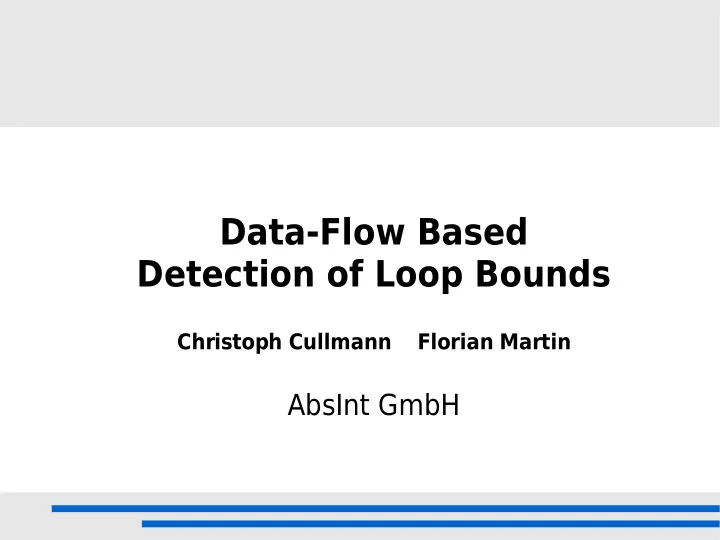

Data-Flow Based Detection of Loop Bounds Christoph Cullmann Florian Martin AbsInt GmbH
Motivation Most time-critical programs on embedded systems contain loops We need WCET calculations for them Loop bounds are needed to calculate the WCET
Tools out there There exists already tools for WCET calculation Examples: aiT, Bound-T, SWEET, ... They already include loop analyses
aiT's loop analysis Works on machine code Loops are transformed to procedures Cooperates with value analysis iteratively, multiple iterations to cover nested loops To find loop bounds, use: pattern matching slicing dominator/post-dominator analysis
Why come up with new stuff? Current pattern matching needs: manual adaption for each loop type manual adaption for each compiler, even each optimization mode It's difficult to integrate more complex loops e.g. loops with multiple internal alterations of loop counter
How to improve? Idea: Keeping the proven iterative approach in combination with value analysis replace the fixed patterns with a new data- flow analysis to generate equations for the loop counters This should lead to: being more generic being more flexible
Analysis Steps Collection of loop counters & start values Building of equations for this loop counters via data-flow analysis Inspecting all exits and calculating min/max iterations using found start values, equations and exit informations
Detection of Loop Counters Candidates for loop counters: registers accessed in the loop routine memory cells accessed in the loop routine Simple analysis on the control graph, using value analysis results for memory access Ask value analysis for start values, only keep registers/memory cells with known start values
The Data Flow Analysis Is started with equations for found possible loop counters at first call Will result in equations for possible loop counters annotated to all edges in the loop routine This equations: show alteration of counter in one loop iteration
The used Flow Problem Data flow value: set of equations Each equations contains: destination variable set of all possible values Important: a variable on the right side stands symbolic for the start-value of this variable at the loop entry
Variables? Values? A variable is a triple of: type: register or memory register number or memory address width in bytes (used for overflow checking) A value is a quadruple of: source variable additive constant minimal width in bytes we operate on signedness
Transfer function Forward problem Transfer function, different handling for: normal blocks with instruction recursive loop call of loops returns from loops others: identity Other interesting parts: Combination & Widening
Transfer: for Instructions Two phases: remove all equations for variables which are modified by this instruction add new equations you can derive out of the semantics of the instruction
Transfer: loop rec. call/return loop recursive call: We want to find invariants for one iteration propagate the initial equations of the loop to the call edge loop return: We don't want to propagate flow outside of loops in the current nesting propagate empty set of equations to the return edge
Combination Function We aim for safe results, therefor result will only contain: equations for destination variable for which in both given sets already equations existed right side of equations need to be merged, if not possible, equation must be removed
Widening Problem: the constants in the values can change per iteration only bound by range of integer Solution: Remove all equations which changed si nce last iteration, but existed there already
Evaluation of all exits First: classification of exit: always reached in a iteration? only reached sometimes? this is done by a dominator analysis Only always reached exits can give information about maximal iteration count All exits can give information about minimal iteration count
What to do for each exit? Exits are conditional branches Identify variables/constants used in the compare Identify the condition: =, <, >, ... Build a equation for the found condition and used variables
Derive the loop count We have now: equations for loop counter equation for loop exit We can derive: increment per iteration increment before the compare possible assignment of constant to counter
What's still needed? Get the start value of the loop counter: Query the value analysis! Use the knowledge of the width of the variables: Do we work in 8, 16 or 32 bit range, did overflow happen? Use the knowledge of the signedness: Does the compare type match our variable type?
Combine the bounds For each loop: calculate bound for each exit this way Combine the results to conservative bounds for the whole loop
Simple Example C code: while (r31 < 16) { if (r30 == 0) { r31 = r31 + 1; } else { r31 = r31 + 2; } }
Equations for example { r31 = r31; } { r31 = r31; } { r31 = r31 + 1; } { r31 = r31 + 2; }
Bounds for example Equation for one iteration: r31 = r31 + [1, 2] Start value (for example): r31 = 0 Loop exit equation: r31 >= 16 Solution: min: 9 max: 17
That's it! We use now a data flow analysis to get loop invariants instead of only fixed patterns Practical evaluation shows: It is less compiler dependent It provides a portable solution It's speed/complexity is usable
Future work Applying the method to more architectures Refining the implementation for more complex exit checks Allow constant multiplication in the equations Use a more powerful equation solver to allow more expressive equations
Thanks & Questions?
Recommend
More recommend